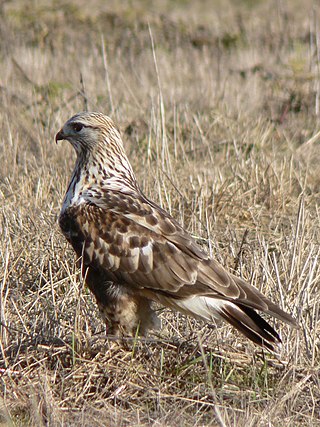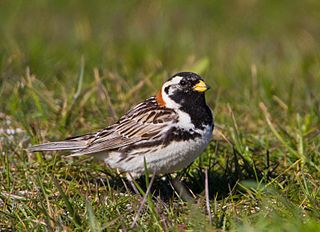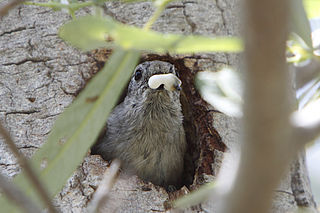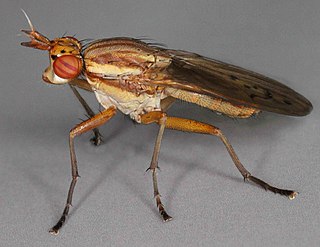
The Accipitridae is one of the three families within the order Accipitriformes, and is a family of small to large birds of prey with strongly hooked bills and variable morphology based on diet. They feed on a range of prey items from insects to medium-sized mammals, with a number feeding on carrion and a few feeding on fruit. The Accipitridae have a cosmopolitan distribution, being found on all the world's continents and a number of oceanic island groups. Some species are migratory. The family contains 255 species which are divided into 70 genera.

The snow bunting is a passerine bird in the family Calcariidae. It is an Arctic specialist, with a circumpolar Arctic breeding range throughout the northern hemisphere. There are small isolated populations on a few high mountain tops south of the Arctic region, including the Cairngorms in central Scotland and the Saint Elias Mountains on the southern Alaska-Yukon border, as well as the Cape Breton Highlands. The snow bunting is the most northerly recorded passerine in the world.

The rough-legged buzzard (Europe) or rough-legged hawk is a medium-large bird of prey. It is found in Arctic and Subarctic regions of North America, Europe, and Russia during the breeding season and migrates south for the winter. It was traditionally also known as the rough-legged falcon in such works as John James Audubon's The Birds of America.

The yellowhammer is a passerine bird in the bunting family that is native to Eurasia and has been introduced to New Zealand and Australia. Most European birds remain in the breeding range year-round, but the eastern subspecies is partially migratory, with much of the population wintering further south. The male yellowhammer has a bright yellow head, streaked brown back, chestnut rump, and yellow under parts. Other plumages are duller versions of the same pattern. The yellowhammer is common in open areas with some shrubs or trees, and forms small flocks in winter. Its song has a rhythm like "A little bit of bread and no cheese". The song is very similar to that of its closest relative, the pine bunting, with which it interbreeds.

The Lapland longspur, also known as the Lapland bunting, is a passerine bird in the longspur family Calcariidae, a group separated by most modern authors from the Fringillidae.

The American kestrel, also called the sparrow hawk, is the smallest and most common falcon in North America. It has a roughly two-to-one range in size over subspecies and sex, varying in size from about the weight of a blue jay to a mourning dove. It also ranges to South America and is a well-established species that has evolved into 17 subspecies adapted to different environments and habitats throughout the Americas. It exhibits sexual dimorphism in size and plumage, although both sexes have a rufous back with noticeable barring. Its plumage is colorful and attractive, and juveniles are similar in plumage to adults.

A fecal sac is a mucous membrane, generally white or clear with a dark end, that surrounds the feces of some species of nestling birds. It allows parent birds to more easily remove fecal material from the nest. The nestling usually produces a fecal sac within seconds of being fed; if not, a waiting adult may prod around the youngster's cloaca to stimulate excretion. Young birds of some species adopt specific postures or engage in specific behaviors to signal that they are producing fecal sacs. For example, nestling curve-billed thrashers raise their posteriors in the air, while young cactus wrens shake their bodies. Other species deposit the sacs on the rim of the nest, where they are likely to be seen by parent birds.

The Arctic lemming is a species of rodent in the family Cricetidae.

The rufous-breasted sparrowhawk, also known as the rufous-chested sparrowhawk and as the red-breasted sparrowhawk, is a species of bird of prey in the family Accipitridae. It is found in Angola, Democratic Republic of the Congo, Eritrea, Eswatini, Ethiopia, Kenya, Lesotho, Malawi, Mozambique, Rwanda, South Africa, South Sudan, Tanzania, Uganda, Zambia, and Zimbabwe.

The snow leopard, commonly known as the ounce, is a species of large cat in the genus Panthera of the family Felidae. The species is native to the mountain ranges of Central and South Asia. It is listed as Vulnerable on the IUCN Red List because the global population is estimated to number fewer than 10,000 mature individuals and is expected to decline about 10% by 2040. It is mainly threatened by poaching and habitat destruction following infrastructural developments. It inhabits alpine and subalpine zones at elevations of 3,000–4,500 m (9,800–14,800 ft), ranging from eastern Afghanistan, the Himalayas and the Tibetan Plateau to southern Siberia, Mongolia and western China. In the northern part of its range, it also lives at lower elevations.

Calcariidae is a small family of passerine birds. It includes longspurs and snow buntings. There are six species in three genera worldwide, found mainly in North America and Eurasia. They are migratory and can live in a variety of habitats including grasslands, prairies, tundra, mountains, and beaches.

The Eurasian goshawk is a species of medium-large bird of prey in the family Accipitridae, a family which also includes other extant diurnal raptors, such as eagles, buzzards and harriers. As a species in the genus Accipiter, the goshawk is often considered a "true hawk". The scientific name is Latin; Accipiter is "hawk", from accipere, "to grasp", and gentilis is "noble" or "gentle" because in the Middle Ages only the nobility were permitted to fly goshawks for falconry.

Ornithomya avicularia is a species of fly in the family Hippoboscidae. It is found in the Palearctic. The species prefers tree-dwelling birds as hosts.

Culiseta annulata is a species of mosquito in the family Culicidae. It is found in the Palearctic.

Ilione albiseta is a species of fly in the family Sciomyzidae. It is found in the Palearctic. The larva preys on Galba truncatula

Scathophaga inquinata is a species of fly in the family Scathophagidae. It is found in the Palearctic. It has a pale, orangey brown abdomen, orange legs, and plumose arista and is often found on pond edges or in wet meadows.

Scathophaga litorea is a species of fly in the family Scathophagidae. It is found in the Palearctic.

Scathophaga suilla is a species of fly in the family Scathophagidae. It is found in the Palearctic.

Syntormon pallipes is a species of fly in the family Dolichopodidae. It is found in the Palearctic, Oriental and Afrotropical realms. In 2019, the mitochondrial genome of S. pallipes was sequenced, as the first representative of the subfamily Sympycninae.

DNA barcoding in diet assessment is the use of DNA barcoding to analyse the diet of organisms. and further detect and describe their trophic interactions. This approach is based on the identification of consumed species by characterization of DNA present in dietary samples, e.g. individual food remains, regurgitates, gut and fecal samples, homogenized body of the host organism, target of the diet study.




















